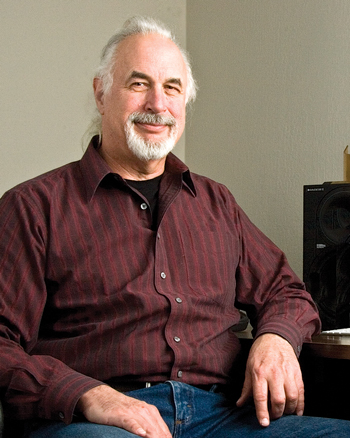|
Vol. 231 No. 11 |
 |
|
| NELL LUKOSAVICH, ASSOCIATE EDITOR |
Science, sound and serendipity, from geophysics to hip hop
If the hip hop community ever decides to embrace oil and gas as a lyrical theme, its first big hit would have to be an ode to Dr. Andy Hildebrand, founder of Antares Audio Technologies. As a former geophysicist for ExxonMobil, co-founder of Landmark Graphics and inventor of the audio pitch-correction technology Auto-Tune, Hildebrand has masterminded the ways in which sound is engineered.
Hildebrand, a lifelong flute player, received a PhD in electrical engineering from the University of Illinois in 1976. He began his career with Exxon Production Research as a geophysicist, where he learned about the application of velocity, imaging and linear estimation theories to seismic interpretation.
Hildebrand also learned the value of thinking outside of the box. “My biggest success [was] a processing problem,” he said. When extrapolating the extent of an offshore oil field, Hildebrand’s attempts to increase resolution by applying the deconvolution algorithm distorted the results of the field’s seismic data. He decided to move-out correct the data and study it without stacking. “I ended up rolling out a 100-ft long roll of pre-stacked paper and [said] ‘This is where the field ends’,” said Hildebrand.
In 1982, Hildebrand and several partners teamed up to develop a workstation that enabled users to analyze and share huge quantities of seismic data. “We added some graphics to that workstation and demonstrated it as a proof of concept to venture capital people in the process of starting [Landmark],” he said.
The team introduced their workstation concept at the Society of Exploration Geophysicists (SEG) Annual Meeting in 1983, and Landmark made its entrance into the international market in 1984 with the distribution of three interactive workstations to Melbourne, London and Dallas.
By 1989, Landmark had revolutionized the world of 3D interpretation software. The company released the OpenWorks software suite, which provided a common user interface for E&P applications, a common data model and a set of data management tools, including patented interprocess communication technology.
Hildebrand left Landmark in 1989 and returned to his first great passion: music. “I thought I had retired. I went back to school for fun,” he said. Hilde- brand studied composition at Rice University’s Shepherd School of Music and, through using electronic synthesizers, he developed a way to seamlessly loop complex audio samples, something which had never previously been done. “It was serendipity,” he said.
Whereas digital filters are used in seismic processing to reduce the amount of noise in data, in audio, the same filters are used to change tone. “In audio, the autocorrelation function is used to determine pitch. In seismic, it is used to determine arrival times, attenuate reverberations, cross-correlate arrivals in reflection statics, etc.,” said Hildebrand. He soon realized that there was a market for digital signal processing (DSP) technology and came out of his “retirement” in 1990 to found Jupiter Systems (now Antares Audio Technologies).
While working on a series of software plug-ins and voice processors, Hildebrand found himself in another serendipitous situation. At a luncheon, a friend’s wife asked Hildebrand if he could make a box that could help her sing in tune. He went to work developing real-time pitch-correction software based on geophysical algorithms and DSP technology.
The result, Auto-Tune, started a revolution that forever changed the way in which music is recorded and shared.
“A lot of artists owe their careers to Auto-Tune, especially [in terms of] live performances,” said Adam Hawk, founder of Hawksound. “If you’re in this industry, you will use Auto-Tune.”
Auto-Tune is currently used in more than 90% of production studios, with applications from recording music to live broadcasts to a whole other world of satires. ESPN’s SportsCenter, for example, has used Auto-Tune to create music videos out of interviews with athletes. Bill Falls, production assistant for ESPN, believes Auto-Tune has “captured the attention of younger audiences because it is trendy and funny.”
Named as one of the hottest brands by Ad Age magazine in 2009, Auto-Tune has recently entered the mobile space. Dr. Ge Wang is founder of Smule, which partnered with Antares and rap artist T-Pain for its “I Am T-Pain” iPhone application. “Auto-Tune introduced a whole new era. Whether you love it or hate it, Auto-Tune intrigued you,” said Wang. “It is a new way for people to connect all around the world [through] a medium that is anonymous and unmistakably human.”
Hildebrand, who was presented with an Enterprise Award from SEG in 1999, credits the oil and gas industry with teaching him how to manage a business, work with people and create processing “with pristine quality.” He is currently developing new mobile applications by applying the same algorithms and processing model from his early geophysical days.
To Hildebrand (who continues to play the flute and rarely listens to pop music), science and music are all about imagination and learning from your mistakes, or “missed opportunities” as he calls them. His favorite gift is one a friend gave him when he won the Enterprise Award: a simple cube made out of a wire frame. A seesaw inside the cube has a big weight on one side and on the other side, outside of the cube, a man in a thinking position. “It always reminds me that in order to think outside of the box, you need a big weight—knowledge—inside the box.” 
|




